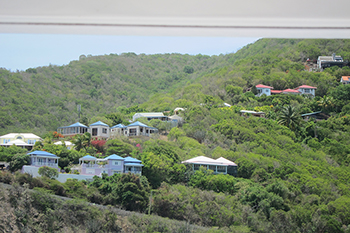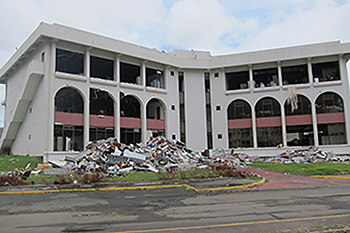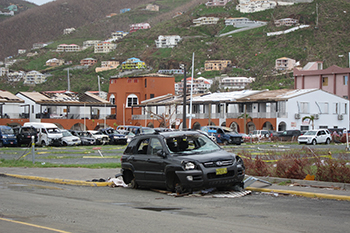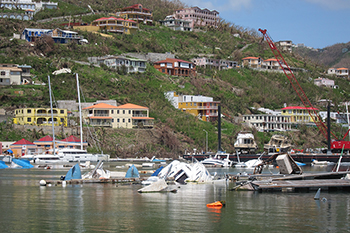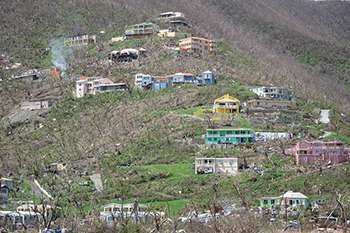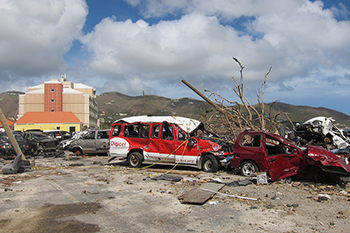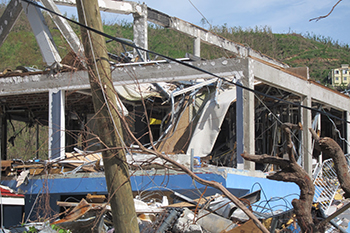
With a triple assault of hurricanes—Harvey, Irma and Maria—this past summer slamming into the Texas, Florida and Caribbean coasts, University of Arizona College of Medicine – Tucson physicians Tammy Clark Ojo, MD, and husband, Akinlolu Ojo, MD, MPH, PhD, volunteered for a medical mission to assist with medical care on the island of Tortola, the largest of the British Virgin Islands.
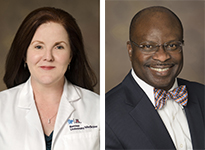 The three hurricanes are among the top five costliest in U.S. history. In late August, Harvey dumped 19 trillion gallons of water on the Houston and Baton Rouge areas. Irma—making landfall Sept. 10 in Florida after strafing the Virgin Islands—was the strongest ever recorded in the Atlantic Ocean at more than 180 mph wind speeds sustained over 37 hours. Ten days later, Maria struck Puerto Rico, still reeling after a glancing blow from Irma.
The three hurricanes are among the top five costliest in U.S. history. In late August, Harvey dumped 19 trillion gallons of water on the Houston and Baton Rouge areas. Irma—making landfall Sept. 10 in Florida after strafing the Virgin Islands—was the strongest ever recorded in the Atlantic Ocean at more than 180 mph wind speeds sustained over 37 hours. Ten days later, Maria struck Puerto Rico, still reeling after a glancing blow from Irma.
 The devastation was horrific on Tortola, which lies east of Puerto Rico.
The devastation was horrific on Tortola, which lies east of Puerto Rico.
Dr. Clark Ojo is a professor of medicine, Division of Pulmonary, Allergy, Critical Care and Sleep Medicine; director, Adult Cystic Fibrosis Program; and vice chair for clinical affairs for the UA Department of Medicine, while Dr. Ojo is a professor of medicine, UA Division of Nephrology; associate vice president, Clinical Research and Global Health Initiatives, UA Health Sciences; and principal investigator, All of Us℠ Arizona Research Program/Precision Medicine Initiative.
Drs. Clark Ojo and Ojo went to Tortola, Sept. 28-Oct. 3, to help provide clinical services to patients displaced from the hurricanes, which left thousands of people and facilities—including hospitals and clinics—without power and water. They returned twice since, offering further assistance.
See the following Q&A with Dr. Clark Ojo about their experience with a mini-photo gallery below that:
Q: Which island(s) did you visit?
A: The country of the British Virgin Islands – specifically Tortola (the eye of Irma passed over Sept. 6 at greater than a Category 5 hurricane). With a population of 37,000, more than 8,300 people were displaced with over 4,200 structures damaged.
Q: Were you invited by a particular group to participate/through what organization did you go?
A: The conversation started with an international nephrology society, but we went on our own and made all of our arrangements.
Q: Give us a brief overview of what you did?
A: My husband had provided nephrology consultative services in the past and was credentialed to work there and I quickly got credentialed (they were very motivated). A big area of need was the dialysis unit (the physician who consults typically travelled from Puerto Rico weekly, but had not been able to get there for >3 weeks), so those patients had not been seen by a physician. Everything was being held together by the dialysis team of nurses and technicians. We quickly got established in the dialysis unit and performed full examinations on all patients (many were diabetic and some had foot injuries that needed to be assessed/treated). We reviewed/revised all dialysis plans. I also helped in the Emergency Room and the ICU (all of the physicians had been working full speed since the hurricane and were just exhausted). Although the reported death toll from Hurricane Irma was surprisingly low, three weeks afterward, we were seeing the secondary mortality from the catastrophe. Patients needing amputation, etc… What my husband and I were worried about really was more the risk of depression that would occur when the shock wore off. I think that it was also very helpful for the patients/caregiver team to have someone to tell their story to others who had not been there. We heard amazing stories of survival.
Q: What were your overall impressions?
A: First impression was that all of the trees and all of the leaves were gone (just gone). Only about 15% of the homes were what we would consider habitable (and people were still trying to live there). About 75% of the boating fleet and 75% of the cars on the island were destroyed. What passed for a drivable car was almost like a cartoon (no windows, doors held closed with a piece of rope). Vans, huge ferries, yachts were lying in locations and positions that made it look like a hand had tossed them there. It looked liked a huge bomb had detonated. We took in all of that at once when we stepped onto the dock off of the first ferry to travel over from St. Thomas.
The second impression was the calm and focused industry of the people of the island. It was very safe. No looting and none of the events/activities that had been reported on the news. Everyone smiled when you met their eye. I was so impressed with the fact that the roads were cleared, and they had already set up multiple distribution points for fresh drinking water access. They had established a curfew of 8PM (previously it had been 6PM). Many of our friends and co-workers at the hospital were sharing apartments/houses (several families might be living in a house), and one of the floors of the hospital was occupied by hospital workers and their families. We already had such a close relationship to the island and its people. This trip deepened that.
We have returned twice since then on “vacation.” There is visible change in regard to rebuild. The schools have opened. Several of the major marinas and hotels are open and still making repairs simultaneously. The big cruise ships are returning. The island was green again when we last went. It is a beautiful place. Life goes on.
PHOTO GALLERY (Sept. 28-Oct. 3, 2017—other than first photo from a 2015 trip to the area by the Ojos for comparison—click image to enlarge):
—David Mogollón
ALSO SEE:
“Ways to Help Disaster Relief Action – Mexico, the Caribbean, Florida & Texas” | Posted Sept. 26, 2017


